If you are anything like I was about a decade back, all you needed to know about ammunition storage was ammo could survive the trip from your shopping cart to the checkout, and from the checkout to the range.
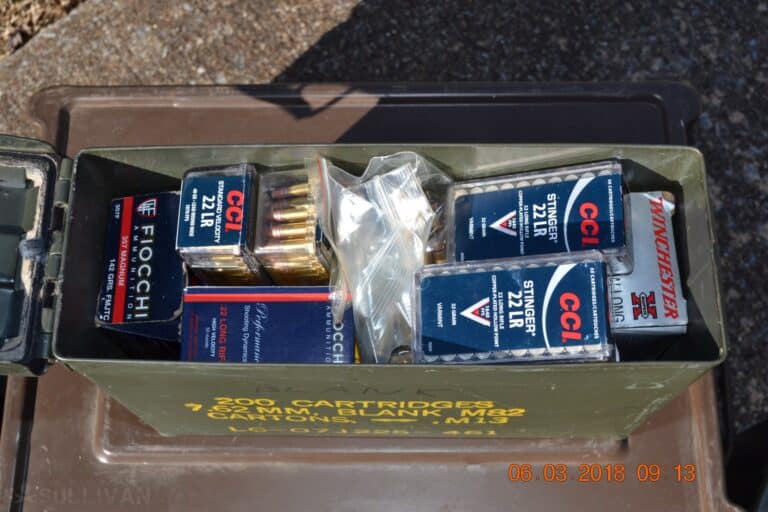
Ammunition had a short life as far as I was concerned, destined to be bought and promptly consumed in the chamber of a gun.
I lived in Florida at the time, a very gun friendly state, and with ranges and gun shops on every corner, ammo practically grew on trees.
Yep, planted right next to the oranges. You don’t need to stash what you can never run out of. After all, you can just buy more.
The Great Ammunition Famine
Those days of plentiful supply came to an abrupt halt around 2007.
As is customary, political posturing on the topic of gun and ammo regulation leading up to the presidential election led to rushes on purchasing, and rushes led to panicked hoarding.
The subsequent election of the 44th President of the United States applied further pressure to already straining industries, and all throughout the next 8 years in America there were terrible scarcities of guns and ammunition.
The reserve of many popular cartridges dried up seemingly overnight. Some, like .380ACP and .22LR, would take many years before they would consistently return to store shelves.
My care-free attitude and hubris cost me: I had signed up for a pistol class, and the date was rapidly approaching.
I scoured my city, and surrounding counties, desperately trying to gather enough ammo to attend. I did, barely, by begging off my better prepared friends, and finally assembling a mish-mash of brands, bullet types and weights. They all had different POI’s, some were more reliable in my pistol, others less.
I completed the class, and didn’t wind up looking like a stooge.
I learned a lot on the range, but my biggest lesson was one of preparedness: stock up on ammo, buy it cheap and stack it deep. I started to imagine a scenario where the outcome was not merely wasted money, or reduced training repetitions.
What if I needed that ammo for serious social purposes? What if I had a friend or relative that needed a bunch of ammo in a hurry?
Would I be able to endure a crisis with my ammo on hand? Would I have enough to be the good friend one could count on? No, no I would not.
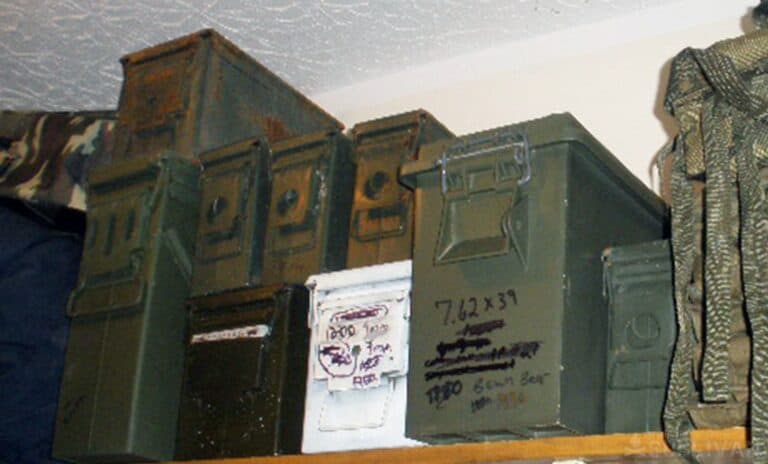
Storage: For a Rainy Day
If you are preparing for any occurrence of widespread societal unrest, collapse or regional disaster, you probably have a decent stash of ammo laid up all ready.
Maybe, like me, you are also dedicated to keeping a goodly amount on hand to ensure you can attend scheduled or impromptu training opportunities. That’s good.
Considering you have a significant (or not so significant) quantity of ammo put away for future use, your next consideration must be making sure it is stored in optimal conditions.
This is to prevent it from degrading, thus wasting your investment, and resulting in malfunctions or, worse, an empty gun in the future.
The length of time you plan to store the ammo, the local humidity at the storage site and the container you store the ammo in will all dictate how long you can expect your ammo to stay fresh. Effective long term storage is safe, and completely achievable by anyone with a small financial investment.
Typically, one will only need a quality metal or plastic ammo can that seals against air and moisture, some desiccant packs, and perhaps heavy, plastic zipper or vacuum-seal bags. Rain’s coming, read on for details!
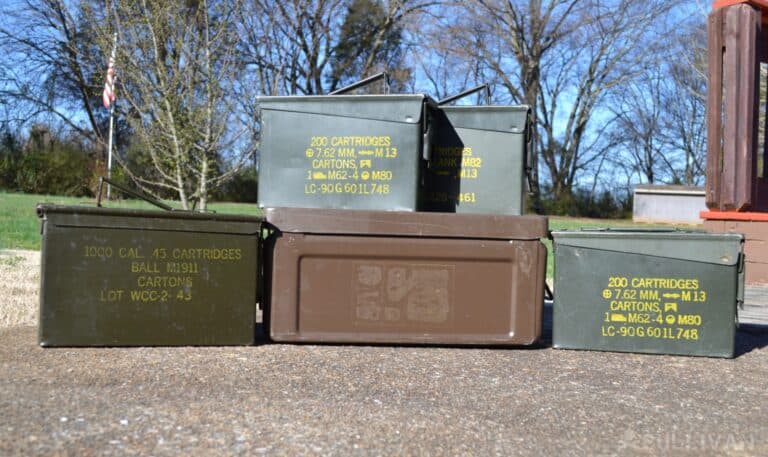
Basics of Storage
Before you go squirreling ammo away in every Tupperware container you have plundered from your significant other or neighbors, it is instructive to understand what we are trying to protect our ammunition from.
The single greatest harmful element to our ammunition is moisture, which leads to corrosion. The other is high temperature; ammo kept cool will last a very long time indeed.
Keep both of these foremost in your mind when you are deciding where to locate your stash. As always, proper storage is essential for long shelf life of any consumable good.
Moisture degrades ammo by causing corrosion, and seeping inside cartridge cases to degrade priming compound and render powder useless.
If you have ever pulled a lone round out from the bottom of a forgotten range bag, or out of an old box in your basement, that green, musty stuff on the brass is a byproduct of corrosion.
Cartridges so afflicted are not to be trusted. The same thing can happen to a big batch of ammo if we do not take steps to mitigate it.
Extreme temperatures, in excess of 150° F according to multiple manufacturers of commercial ammo, will start to degrade both primer and powder over time. This can lead to reduced performance or a complete failure to fire.
Unless you are storing your ammo in an area where temperatures climb above 150°, such as attics, or interior or trunk of a car during summer, this is not a concern in most locales.
Of the two, moisture is the factor we will pay the most attention to and work the hardest to thwart. If we can beat back moisture, ammo will keep viable for at least a decade, and often much longer.
Lucky for you, even in humid climates, solutions are simple and only require a bit of diligence in rotating your stock. This will ensure your ammo is as ready and shiny as the day it rolled off the factory presses.
This means a damp basement or a gun safe in the garage is probably a no-go.
Gather Equipment
The only must-have pieces of storage equipment we require are suitable containers (typically a military or commercial sealing ammo can), some type of desiccant packs (or moisture absorption packs, typically made from silica), and good, sturdy sealable plastic bags.
All are widely available and inexpensive, and in the case of silica packs, found free in all kinds of product packaging.
Start with your containers. I know a lot of people use heavy storage bags filled with loose cartridges and place those inside large plastic food containers, thinking that in conjunction they must surely be adequate.
This is a bad play for a couple of reasons:
- containers of that type offer only a paltry seal against moisture and air, and
- those containers filled with ammo become very heavy, and quickly. I have seen more than few bust their bottoms when being hoisted. Not ideal.
If you don’t already have some, spring for either military surplus metal ammo cans, military-style commercial metal cans or nice, plastic commercial ones.
Both feature high quality rubber gaskets to seal the contents against both air and moisture, and are easily recognized by their rectangular, boxy shape, hinged lids and collapsible handles.
Trust me, quality ammo cans make the difference.
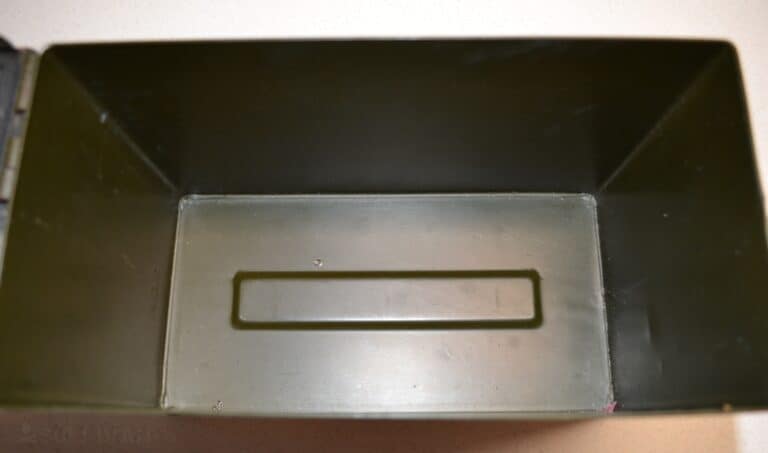
These are available in sizes approximating a lunchbox, enough for a few magazines or boxes, all the way up to very large metal trunks which can hold thousands of rounds.
When shopping for the military cans in particular, pay close attention to the gaskets around the rim, on either the lid or the can itself. Ensure there are no tears, dry rot, rust or major deformations that could compromise the integrity of the seal.
For the commercial plastic containers, make sure they do in fact have a seal, and are of sturdy quality to resist breaking from rough handling, and the weight of their contents.
Have a look at the pics below for an example of a surplus military ammo can in great shape. Pay particular attention to the seal around the lid shown and the interior. That one will only need a little dressing on the seal before it is ready to go.
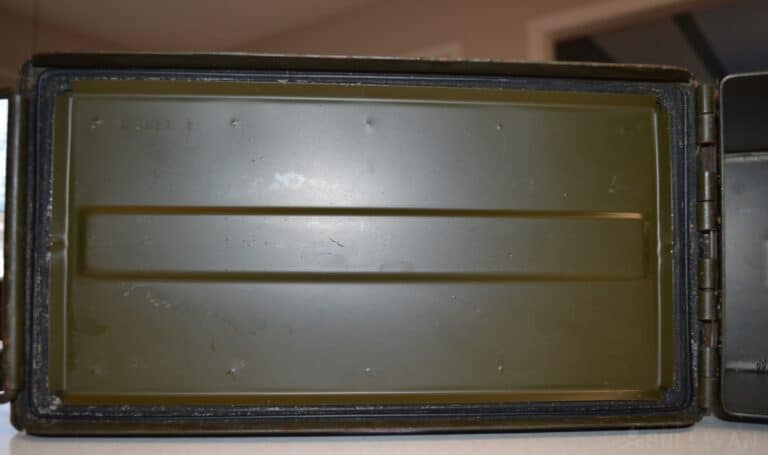
Buy enough, in the right sizes, to accomplish your storage objectives.
This might mean a few small cans for loaded magazines or keeping in vehicles, and a larger chest to keep bulk ammo at home or office. This boils down to personal requirements, so give careful thought to your own situation and needs.
For your silica or other dehumidifier packs, you can use the small bags you get in nearly everything you buy from a store these days, or buy purpose-made ones at any hardware or big-box home improvement store.
You can also buy them by the pallet load on Amazon.
These silica packs won’t work indefinitely: periodically, maybe twice a year in a very humid environment, you will need to dry them out in an oven set on about 140-150° for about 30 minutes.
Set the packs on a pan and pop them in the oven.
While you are at the store, grab a few of the flat, disposable moisture detection cards.
A couple of these will let you check not only the moisture level at the location you plan on storing your ammo, but test your cans for moisture infiltration after you have them in place.
Get To Packing
But before you do, a few rules: If you are handling bulk ammo for long-term storage, wear latex or nitrile gloves.
You may be thinking lead exposure, which is indeed a concern, but the greater issue for our task will be oils from your skin lingering on the cartridges.
Depending on your individual body chemistry, this oil can either cause corrosion eventually or immediately. No real way to know, but if you are the person that has to clean rust off his carry pistol weekly, you need to take extra precaution. Don’t let your efforts go to waste.
Place your moisture tester in the area where you want to locate your stash. Follow the instructions on the tester, and then get a reading after the specified time. Shoot for a moisture reading of 25% or less. Areas that are not well insulated or ventilated are bad choices, typically.
Think sheds, garages and basements. Car trunks can vary. Once you have picked a suitable site, place a small pallet or a platform on the ground if you aren’t using shelves.
Try to avoid having the cans rest directly on the floor, especially in a garage or basement as condensation will be a risk.
For loaded magazines that you plan on storing for a comparatively shorter term, you can place them directly in a can, ready to go, with a desiccant pack and close the can.
Quick note on this- not all magazines are created equal! USGI aluminum M16/AR-15 magazines and some older pattern 1911 magazines may degrade when stored long-term fully loaded, specifically from the pressure of a fully compressed stack of rounds pushing against the frail, easily deformed feed lips.
Magpul’s ubiquitous Pmags feature a top cover specifically designed to prevent such an occurrence, but I am uncertain if they are necessary considering the Pmag’s tougher feed lips. It certainly will not hurt to utilize them.
For bulk ammo, it is a good idea to remove it from any cardboard or paper packaging and place it into your plastic bags. Cardboard and paper both are bad about absorbing moisture.
I have, however, stored ammo in the factory boxes, in cans, with silica for some years in a dry location and used it with no ill effects.
Whichever you decide, do not place your desiccant inside the bag with loose ammo: if, or when, it absorbs enough moisture, it will be trapped against the loose cartridges, which will start to corrode.
The desired outcome is for the desiccant to intercept the moisture that gets past the seal of our can before it can harm the ammunition. Label your bags with manufacturer, caliber, type and date, squeeze out any air, and seal them.
Once all this is done, and your cans are full, close and latch the lid. Don’t forget to toss in a moisture tester in at least one.
Set a reminder to come back and check the moisture tester according to the instructions it came with. If the level is too high inside the can, check your seals. If that does not work, replace the can. If that still does not work, choose another location.
Rotating Your Ammo
You can now be reasonably sure that your ammo supply will be safe from moisture, and assuming you aren’t storing them in a blazing hot location, will keep for a very long time.
Note that even if you are keeping it in, say, your car or truck, most ammo will be fine over the short term if you remember to rotate it out.
So, say I have a stash of loaded pistol mags in a small BOB in my car, after 3 months of summer heat, I am going to pull them out, shoot them in practice or training, and then replenish them with ammo from my stores.
The ammo in my stores will be replenished by new, store-bought ammo, and the cycle repeats itself.
I’ll do the same thing with my store at home: when it is time to train and I need a quantity of ammo to use, I will pull from my oldest stock first. When I replenish later, the next oldest batch will be “on deck” for consumption.
This way I am always assured of having fresh ammo on hand. Ammo, stored well, will typically keep a very long time with no ill effects, but this is another small expenditure of effort to ensure you are keeping an optimal stock.
Other Considerations
You can buy surplus military ammo that will sometimes come in a handy sealed package, be it plastic or metal and ready to store as is.
Russian surplus 7.62x39mm, 7.62x54mm and 5.45x39mm can all be had in the iconic metal “Spam” or “Sardine” can, which is welded shut, and completely impenetrable against any mechanical attempts at breaching it, save a grinder or the specialty can opener which they never come with in America.
If you buy a quantity of such ammo and can test a small batch to ensure function in your firearm, you can store the rest unopened, confident that it will keep until you need it.
As far as quantity is concerned, that is highly dependent upon your individual wants and needs. My attitude about ammo-on-hand is this: For my primary calibers, I want at least twice as much of each as it would take for me to complete a 2 or 3 day class.
Call it about 3,500 rounds each, minimum. That way I can use a large quantity of it for skill development, and have a hard reserve of at least a case in each caliber.
Be sure also to take in to account the bulk and weight of ammo if you plan to flee a crisis. Ammo cans take up a lot of room and weight in vehicles, and space is at a premium. You need to know how much will fit where before it is time to hit the road.
Real World Use Equals Suboptimal Storage
Okay, so we know everything we need to know about storing ammo properly, just the way that the NRA, SAAMI and ammo industry managers would have us do it.
Perfect temperature range, appropriate storage container and humidity hovering just about 5%. That’s great.
So how do we really store ammo out in the real world, in real world conditions when we don’t have control over every variable?
What about when you cannot, because of your objective, store ammunition in such a way then it will be even approximately in ideal temperature and humidity ranges? What if it doesn’t even have a decent container?
Now, you might be the kind of person but this statement just does not apply to, but for the rest of us shooters who do it professionally or just with considerable enthusiasm, reality has a way of reasserting itself.
You’ll have a spare pistol mag in the door compartment of your daily driver. You’ll have a just in case bag in the trunk or stashed in a strategic location with some long gun ammunition in it.
Maybe you have a literal grab bag of loose ammo here or there for whatever reason.
You might even be such a dedicated prepper that you want to bury a cache of ammunition in an undisclosed location, as in literally beneath the ground.
Or perhaps you just live in a place that is so bone-chillingly frigid or hair-singing hot that ideal temperature ranges are a literal fantasy. What do you do then?
The answer is, of course, just do the best you can.The ammunition we enjoy today compared to the metallic cartridges of bygone eras is an order of magnitude more reliable, robust and durable, and they can put up with quite a lot.
In fact, so long as you don’t let the ammo get completely submerged in liquid, anything that your body could endure for a reasonable amount of time ammunition can likely endure for a long time.
How long is a long time? I don’t know; it depends.
It depends on the quality of the components, the quality control utilized by the manufacturer and any special features on the ammunition like ceiling on the primer pocket or case mouth, crimping and so forth that will prevent the intrusion of moisture.
Suffice it to say that military spec ammunition is usually manufactured with an expectation of enduring abusive real-world conditions.
If you are planning on keeping your ammunition in fairly radical conditions, or perhaps stashing it in a cache that will be subjected to temperature extremes or the possibility of considerable moisture, it is probably worth tracking down and investing in for the purpose.
How Bad is Too Bad?
It rarely fails when I go to a public shooting range there will be one of those particular goblins stooping and snooping around on the ready line, elsewhere in the bay or in the spent brass containers looking for discarded but intact cartridges.
I watched guys completely pilfer a misfire bucket for their own purposes before.
Rounds that were dented, dinged and absolutely covered in the green, moss-like patina of corrosion went into their pockets or right into their guns for summary use.
I’ve seen rounds that I wouldn’t have touched with my buddy’s gun function normally.
This little bit of trivia is a roundabout way to answer the question of how bad is too bad when it comes to the condition of our ammunition coming out of suboptimal storage. This is another answer that I can honestly say I don’t know and you likely won’t know either.
Some rounds that look factory flawless don’t work at all, or catastrophically malfunction. Some rounds that look like they aren’t even fit for recycling work normally. It seems a roll of the dice.
Except this: I can promise you when you are dealing with ammunition that is visibly degraded or compromised your chances go up, way up, of having a bad outcome.
Maybe it will be a misfire. Maybe it’ll be a hangfire, or even the dreaded squib.
It isn’t out of the question that you might be facing something seriously wacky like a dramatic pressure spike which could damage or destroy your gun and potentially damage you.
Generally speaking, if I notice some brass discoloration or discoloration of the copper jacket on a bullet I’m not too worried.
But the moment you notice anything truly wacky going on like corrosion of the case, weird deposits around the primer pocket or obvious signs of immersion or substantial moisture infiltration, I’m getting really wary.
If it is discretionary ammo, I might well discard it depending on how much I like the gun in particular that I’m shooting.
If I’m in a real jam, a legitimate jam if you take my meaning, I’ll use this ammo last after everything else and segregate it accordingly.
At that point it is also a good time to expect malfunctions and I have those immediate and remedial action skills tuned up.
As Always, Test, Test, Test
The last thing I will leave readers with is this. I think it is really funny how often people stash ammunition for the long term like it is in a time capsule.
They don’t touch it or think about it until they need it or until a prescribed amount of time has gone by. I understand that, but when you do that you miss out on a tremendous amount of useful data that might otherwise be collected.
I think it is critically important to access ammo you have stored long-term in any conditions, be it at the house, in your vehicle or even stashed in a cache somewhere in the world and then shoot it ahead of schedule, so to speak.
First, it will give you an opportunity to inspect how the ammo looks and how it is holding up.
Second, even shooting a small portion of this ammo will inform your opinion of how your ammo will function when you need it, and how you might be able to expect other ammo to hold up under similar conditions.
All of this talk, all of my experience, and all of my informed opinions are just that, opinions.
Though you can trust that I am telling you the truth and that you can inform your own opinion from mine I don’t know your ammo, how you have it stored or where you have it stored.
Things might be different on your side of the house. The only way you’re going to know is to find out and then you’ll know for sure. Certainty.
Now, as always, you need to test your assumptions. Stash that ammunition, then come back to it after a prescribed amount of time and shoot some of it.
Be safe, and be prudent of course, but go out there and see what happens. Then you’ll know for sure, and you won’t have to wish, hope or pray that your ammo will work when you need it.
You’ll know.
Conclusion
You should ideally be buying ammo in bulk, for the cost savings as well as having a ready supply on hand. Don’t simply leave it sitting around in boxes or baggies for years on end.
Keep your guns fed, and protect your investment of time and money by storing your ammunition properly and you will have taken one more step to ensure you prosper in the face of chaos, whatever form it takes.
How do you have your ammunition stored? How much is enough for your purposes? Have you experimented with alternative methods of keeping your ammo in good condition? Let me know in the comment section!
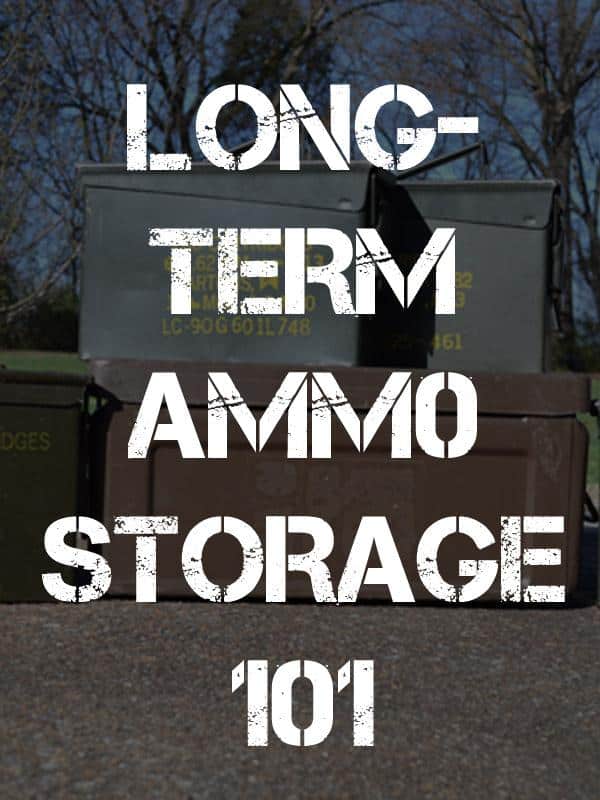

Chad Nabors specializes in firearms, with a strong focus on concealed carry and pistols. His background is in commercial sales and training, and armor development and testing. He has trained many citizens on the pistol from basic to advanced skills. He is a vociferous proponent of the 2nd Amendment, and believes that defense of self and family is a moral obligation. He can be reached at grimgunner (AT) gmail.com.

True story: Why I think I’ll hunker down and stay in place: Back in the heyday f ammo shortages, I was living in a very gun unfreindly place, I hit the reloading bench big time. On hand I had lots of the required items for reloading pistol ammo in 38/357, 45 ACP and 41 mag, and i made good use of things. Lacking suitable small containers, I used a couple of 20mm ammo cans I had laying around. I was able to pretty much fill them. Note to self: A 20mm can filled with 38 ammo requires a dolly to move more than a few feet. They are great for storage, but are essentially immovable objects. I used desiccant packs and watched the temps, and I have used ammo loaded many, many years ago with no noticeable degradation. Just something to think about when storing big time!
Good thinking, Grayfox. A great many people underestimate the sheer weight and bulk of containers densely loaded with ammo, especially folks who are planning to load up and flee a disaster or crisis situation.
Thanks for reading!
I’ve had the weight thing in mind for my storage. The ammo is in a locked steel cabinet but loaded into smaller plastic ammo cans. The goal was/is manageable portions should I need to move a lot of it (all of it?) quickly. Need to watch for Harbor Freight’s next sale on ammo cans, as some boxed purchases are starting to pile up.
Hey, Mic. That’s a smart play on keeping your ammo stashed in smaller cans to facilitate transport.
One word of caution on cheap commercial ammo cans: if you are counting on them for a good environmental seal, you will need to test them. I tried an ad hoc test some years back with good condition, genuine US mil. surplus cans, and the lookalike knockoffs. The knockoffs’ seals did not work at all.
They still worked just fine for toting the ammo and protecting it in transit, though, so there is that. Thanks for reading, I hope you found it useful!
I’ve had excellent success in long term storage of ammunition all through the last Ammo Drought. For many years I stockpiled .22LR Ammunition so, that when the Ammo Drought arrived, it wasn’t an issue for us at all. People thought we were nuts for buying so much .22 and .22 Magnum Ammunition. I just don’t care what the crowd thinks says, or does. We use smaller polycarbonate ammo type cans with goos success, so we are not giving ourselves hernias trying to lift or move Uber heavy cases of loaded ammunition. We reload as well. We store in a consistent temperature atmosphere, in a secure location.
No doubt you were one of the few who had any .22 back in those days, Snodgrass!
Thanks for reading!
I don’t use desiccant pouches, never have.
I don’t put on small amounts of lacquer nail polish around the rim of the case or over the primer as some people suggest.
I store in metal ammo cans for convenience, but mostly have ammo boxes on shelves in the garage, and this has gone on for as long as I can remember, 60+ years. The garage is not climate controlled.
I recently pulled out and shot some .45 ACP handloads that were loaded in August of 1997, and they performed flawlessly.
I have some paper shotshells that came from my father in law and his father before him. Originally purchased and kept in North Carolina and Florida. They shoot fine, as does the .30-06 ammo that has been around just as long, and travelled just as far.
I am shocked to hear that the paper shotshells have lasted that long and produced no hiccups, George.
That’s really cool to hear though. I am not surprised about the other ammo fairing well in the garage, as out modern ammo (or ammo made with modern components) is extremely forgiving of anything except extreme climates.
For my money, I prefer to control as many variables as I can, though it is a rarity for any case of ammo to last more than a year with me.
Thanks for taking the time to read, I hope you enjoyed it!
Have reloaded for better than 40 yrs. Obummer set me off and Walking Dead. Have ammo hidden under ground in three locations. All stocked up on reloading supplies. All sealed up. Will last longer than me.
I use military ammo cans and I put 30 rounds in a vacuum seal bag, suck out air and seal them. I also seal the 30 round mags. Can get 450 to 500 223 rounds per can which does not make the cans to heavy. Also do this for 38 and 45’s.
Living close to Ft. Bragg, N.C., I’ve always had an easy access to ammo cans but they can get scarce depending on the government’s attitude towards re-cycling. I have used WW1 ammunition and had zero malfunctions and I keep mine in government ammo boxes in my cool enclosed basement with a dehumidifier.
Another effective way to store (loose) ammo is in paint cans.
Pint and quart cans can be purchased at your local paint store.
They are great for .22 ammo.
Hey, Bruce. Interesting idea! Never thought of that, but I think the concept is sound; clean paint cans do seal up pretty tightly.
Good thinking.
When I buy ammo (in bulk) I typically leave it in the factory 50 rd boxes and vacuum seal a couple boxes at a time then straight to a steel ammo can. Works great.
Have an idea, but would like some opinions. Thinking of storing my ammo in plastic bags, in 5.56 ammo cans, then put them in a 20mm ammo can with about 2 inches of cat litter in the bottom for moisture absorption. Thoughts?
that is an idea, should work but you never know until you try it